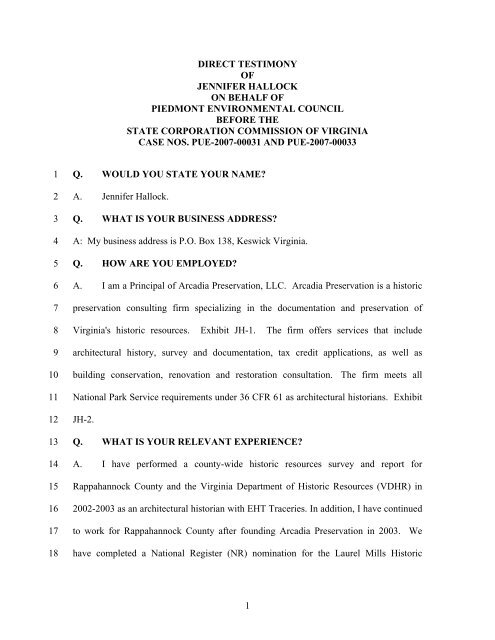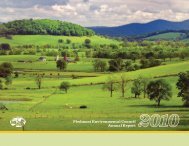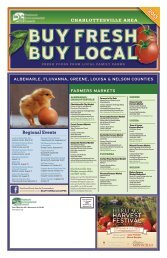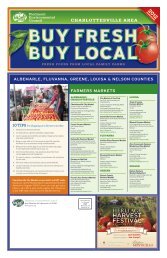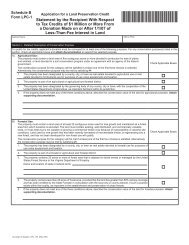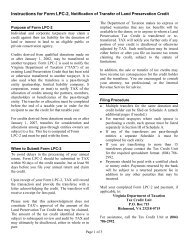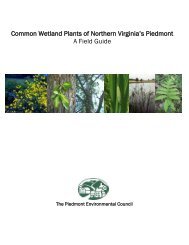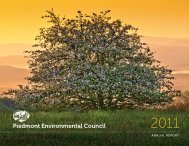Expert Testimony of Ms. Jennifer Hallock - Piedmont Environmental ...
Expert Testimony of Ms. Jennifer Hallock - Piedmont Environmental ...
Expert Testimony of Ms. Jennifer Hallock - Piedmont Environmental ...
You also want an ePaper? Increase the reach of your titles
YUMPU automatically turns print PDFs into web optimized ePapers that Google loves.
DIRECT TESTIMONYOFJENNIFER HALLOCKON BEHALF OFPIEDMONT ENVIRONMENTAL COUNCILBEFORE THESTATE CORPORATION COMMISSION OF VIRGINIACASE NOS. PUE-2007-00031 AND PUE-2007-00033123456789101112131415161718Q. WOULD YOU STATE YOUR NAME?A. <strong>Jennifer</strong> <strong>Hallock</strong>.Q. WHAT IS YOUR BUSINESS ADDRESS?A: My business address is P.O. Box 138, Keswick Virginia.Q. HOW ARE YOU EMPLOYED?A. I am a Principal <strong>of</strong> Arcadia Preservation, LLC. Arcadia Preservation is a historicpreservation consulting firm specializing in the documentation and preservation <strong>of</strong>Virginia's historic resources. Exhibit JH-1. The firm <strong>of</strong>fers services that includearchitectural history, survey and documentation, tax credit applications, as well asbuilding conservation, renovation and restoration consultation. The firm meets allNational Park Service requirements under 36 CFR 61 as architectural historians. ExhibitJH-2.Q. WHAT IS YOUR RELEVANT EXPERIENCE?A. I have performed a county-wide historic resources survey and report forRappahannock County and the Virginia Department <strong>of</strong> Historic Resources (VDHR) in2002-2003 as an architectural historian with EHT Traceries. In addition, I have continuedto work for Rappahannock County after founding Arcadia Preservation in 2003. Wehave completed a National Register (NR) nomination for the Laurel Mills Historic1
1234567891011121314151617181920212223District and are currently completing eligibility reports, a Preliminary Information Form(PIF), for four rural historic district nominations.Q. WHAT IS THE PURPOSE OF YOUR TESTIMONY:A. Counsel for the <strong>Piedmont</strong> <strong>Environmental</strong> Council asked me to analyze the effecton the Rappahannock County Comprehensive Plan (available athttp://www.rappahannockcountyva.gov/page3/page3.html) <strong>of</strong> the proposed 500-kVMeadow Brook-Loudoun transmission line (Loudoun line) alternatives in theseproceedings. I have done so and will show that the proposed transmission line will gothrough a part <strong>of</strong> the country that has undertaken serious efforts to protect the land in acomprehensive way both through local planning efforts and through private preservationactions that are rigorously reviewed by state agencies at every step. These goals areimplemented through zoning, subdivision ordinances, Land Use Assessments,Agricultural Forestal Districts, Open Space Easements, Scenic Easements and HistoricDistricts that adhere to the stated goals and objectives. The Loudoun line is clearly inopposition to these goals. Exhibit JH-3.Because I have a particular background in Rappahannock County I willdemonstrate that the goals and objectives <strong>of</strong> the Rappahannock County ComprehensivePlan will be badly compromised and the Loudoun line will adversely affect a largenumber <strong>of</strong> historic properties located along the line’s proposed routes.Q. WERE YOU ASKED, MS. HALLOCK, TO FOCUS ON PARTICULARASPECTS OF THE APPLICATIONS?A. Yes. Counsel asked me to look at the impact <strong>of</strong> the lines on historic propertiesand Historic Districts.2
1234567891011121314151617181920212223Q. ARE YOU FAMILIAR WITH THE IDENTIFICATION, EVALUATIONAND CREATION OF HISTORIC DISTRICTS?A. Yes. I am.Q. DO THE ROUTES PROPOSED IN THE APPLICATIONS HAVE ANIMPACT ON HISTORIC DISTRICTS?A. Yes. Both the Preferred and Alternate Routes will impact Historic Districts. TheAlternate Route, in particular, impacts many Historic Districts, including the JohnMarshall/Leeds Manor Historic District, the Crooked Run Valley Historic District, theMarshall Historic District and several others. The Preferred Route also impacts the JohnMarshall/Leeds Manor Historic District, the Remington Historic District, and theBristersburg Historic District, among others. Both routes impact the ManassasBattlefield and Manassas Battlefield Historic Expansion Districts.Q. WHAT IS REQUIRED TO CREATE A HISTORIC DISTRICT?A. The process for listing a property on the NR is a rigorous process overseen on thestate level by the VDHR and at the federal level by the National Park Service, as the U.S.Congress directed in the National Historic Preservation Act <strong>of</strong> 1966. Available at:http://www.nps.gov/history/local-law/nhpa1966.htm. A multi-tiered registration processprovides checks and balances at various points in the application process to ensure thatthe <strong>of</strong>ficial determination and listing is non-biased and is not arbitrary or capricious.Q. MS. HALLOCK, CAN YOU DESCRIBE HOW THAT PROCESS ISCARRIED OUT IN VIRGINIA?A. Yes. A PIF is submitted to the Regional VDHR <strong>of</strong>fice for initial review. Theapplication includes an architectural description, significance statement, photographs,3
1234567891011121314151617181920212223maps, and a boundary explanation and justification. After review at the Regional VDHR,the completed PIF is forwarded to the main VDHR <strong>of</strong>fice in Richmond. After furtherreview by an in-house Evaluation Team, the PIF is then publicly reviewed by the StateReview Board that meets quarterly. Once the Board determines the property eligible, theproperty may proceed with a full NR nomination.Q. CAN YOU DESCRIBE WHAT HAPPENS NEXT?A. Certainly. A NR nomination follows a rigorous process similar to the PIF. Thenomination form is more detailed and will incorporate any suggestions from the ReviewBoard at the PIF level. Additionally, the nomination will fully address the requiredhistoric significance and integrity <strong>of</strong> the property as stipulated by the NR <strong>of</strong> HistoricPlaces criteria and will present defendable boundaries. Exhibit JH-4. A review processmoves from the Regional VDHR <strong>of</strong>fice, to the main VDHR <strong>of</strong>fice. A letter to all ownersand adjacent owners is also mailed asking for public comment or opposition. Thenomination is then presented to the State Review Board at a public quarterly meeting. Atthis point, a favorable review culminates with listing on the Virginia Landmarks Register.The nomination is then forwarded to the National Park Service for final approval. Forfurther information, the process is fully detailed in Virginia’s Historical Registers: AGuide for Property Owners, a publication by VDHR.Q. ARE THE NOMINATIONS PUBLICLY AVAILABLE?A. Yes. The National and State Nominations are all on-line athttp://www.dhr.virginia.gov/registers/register_counties_cities.htmQ. WHAT IS THE SIGNIFICANCE OF HISTORIC DISTRICTS TO THECULTURAL LANDSCAPE OF THIS AREA?4
1234567891011121314151617181920212223A. Yes. Each has undergone the vigorous application process at either the PIF or fullNR listing level. It is the pr<strong>of</strong>essional opinion <strong>of</strong> Arcadia Preservation that this processhas been followed in each case and that the final determination <strong>of</strong> eligibility or fullnomination is neither arbitrary nor capricious. A review <strong>of</strong> each nomination form hasseconded that opinion. The criteria for listing are justified in each case and theboundaries appear to be drawn to sufficiently substantiate the property’s historicsignificance and integrity.Q. IN YOUR REVIEW OF THE APPLICATIONS, DID YOU LOOK FORINDICATIONS OF HOW THE APPLICANTS PROPOSED TO MITIGATE THEIMPACT ON THESE HISTORIC DISTRICTS?A. Yes. I looked for mitigation. The photographs and text in the Department <strong>of</strong><strong>Environmental</strong> Quality supplement and the DHR appendix shows that the applicantsappear to rely exclusively on topography or existing vegetation to mitigate the impacts <strong>of</strong>the proposed transmission line and poles. The John Marshall/Leeds Manor HistoricDistrict is good example <strong>of</strong> how the applicants approached mitigation.Q. WHAT DID THE APPLICANTS DO, MS. HALLOCK?A. The John Marshall/Leeds Manor Historic District encompasses 22,184 acres. It isrepresented in the DHR appendix with a single photograph taken from behind a hill 3,900feet from the proposed route. A better representation <strong>of</strong> the impact on JohnMarshall/Leeds Manor Historic District is found in the viewshed analysis and DHR maplocator sheet 1 <strong>of</strong> 2 for the alternate route. This shows the severe impact that will beimposed on many areas within this area and the Crooked Run Valley Rural HistoricDistrict and the Markham Historic District.5
12345678910111213141516171819202122Q. WHAT IS YOUR ASSESSMENT OF THE APPLICANTS’ APPROACH?A. That the applicants are using selective photography conceal the severe damagethat the Loudoun line will inflict on historic districts. They are not proposing any activemeasure to minimize the adverse effects <strong>of</strong> their routes, instead relying on hills andseasonal tree cover to hide the line in some places.Q. ARE YOU FAMILIAR WITH SPECIFIC AREAS WHERE THEPROPOSED TRANSMISSION LINE WOULD HAVE AN IMPACT?A. Yes, very much so. Since founding Arcadia Preservation in 2003, I have workedwith Rappahannock County to develop findings from the survey into historic districts,rural historic districts, and individual NR listings. This process is continuing.Q. CAN YOU DESCRIBE RAPPAHANNOCK COUNTY?A. Yes. Rappahannock County, Virginia is a small county located in Virginia’snorthern <strong>Piedmont</strong> region. With a land mass <strong>of</strong> 266.6 square miles and 26 persons persquare mile, Rappahannock is rural, with one <strong>of</strong> the lowest population densities in thestate. Located on the ex-urban fringe just 65 miles from Washington, DC, the county’srural character has been intentionally retained through careful planning and theimplementation <strong>of</strong> successful land preservation policies.Q. PLEASE DESCRIBE THE CHARACTER OF RAPPAHANNOCKCOUNTY?A. Fifty percent <strong>of</strong> its land are located within the boundaries <strong>of</strong> Shenandoah NationalPark, 34 percent <strong>of</strong> the land is designated as agricultural land use, 7.6 percent is vacant,and only 1.92 percent is considered developed.6
1234567891011121314151617181920212223Q. CAN YOU DESCRIBE THE POPULATION OF RAPPAHANNOCKCOUNTY?A. Yes. As <strong>of</strong> 2000, Rappahannock’s population was 6,983 persons. This haschanged little, and has actually decreased since 1940 (population 7,208). Serving as anagricultural district and a commuter and weekender community, the population <strong>of</strong>Rappahannock County in general is educated and dedicated to preserving the character <strong>of</strong>its county. Commitment to retaining Rappahannock’s rural “scenic” character hasconstrained suburban development, both residential and commercial. As a result thecounty is structured on a village system, with numerous local villages providing theevery-day needs to the local community. Consequently, no shopping malls, large-scalegrocery stores, fast-food restaurants, or stoplights are located within the county.Q. UPON WHAT DO YOU BASE YOUR CONCLUSION THAT THERESIDENTS OR THE COUNTY ARE TRYING TO PRESERVE A RURALSCENIC CHARACTER?A. Using Rappahannock County’s Comprehensive Plan as evidence, it is clear thatthe retention <strong>of</strong> the county’s rural character and scenic beauty are guiding principles tothe county’s everyday decision-making and long-range planning. The ComprehensivePlan acknowledges that “as a rural jurisdiction on the ex-urban fringe <strong>of</strong> the WashingtonD.C. Metropolitan Area, Rappahannock County has been made acutely aware <strong>of</strong> the everchangingdynamic <strong>of</strong> growth and development.” Exhibit JH-5. However, “a longtradition <strong>of</strong> progressive planning and land use policy” has been undertaken because it iswidely acknowledged that “Rappahannock is unique and that there is a natural beauty andorder that command our respect.” Exhibit JH-5.7
1234567891011121314151617181920212223Q. IS THIS COMPREHENSIVE PLAN A REACTION TO THE PROPOSEDLINE, MS. HALLOCK?A. No. The Plan was created 45 years ago in 1962. Since that time it has evolved tomeet the community’s growing challenges while keeping the its original goals andprincipals as guidelines for shaping the “scenic” county’s future.Q. DOES THE COMPREHENSIVE PLAN ATTEMPT TO GUIDE THEDEVELOPMENT OF THE COUNTY?A. Yes, it does. Within the framework <strong>of</strong> the Land Use Plan, scenic county isdefined as “one in which preservation and enhancement <strong>of</strong> the natural and historic beautyand cultural value <strong>of</strong> the countryside shall be respected as being <strong>of</strong> foremost importance.”Exhibit JH- 3. Goals pursuant to these principals include “To preserve the overallviewshed <strong>of</strong> the county in its unspoiled, natural setting, which gives it special characterand identity” and “To protect the natural, scenic, and historic resources, thus ensuring ahigh quality <strong>of</strong> life for our citizens.” Exhibit JH-3.Q. DOES THE COUNTY ALSO SEEK TO PROTECT ITS HISTORIC ANDNATURAL CHARACTER?A. Yes. Other principals set forth by the Comprehensive Plan include “Preserve thenatural, historic, recreational and scenic values, along with the healthy economy <strong>of</strong> theforested land and resource preservation districts so as to ensure that development in thoseareas is in conformance with their natural beauty and environmental limitations,” to“[p]rotect natural resources including soils, water, air, viewsheds, scenery, and fragileecosystems,” to “[p]reserve and protect the historic character and features <strong>of</strong> the county,”to “[e]nsure that the provision <strong>of</strong> capital improvements…enhances the quality and8
1234567891011121314151617181920212223character <strong>of</strong> rural and open-space environments,” and to “[p]romote the philosophy thatland is a finite resource and not a commodity, that all citizens are stewards <strong>of</strong> the land,and that the use and quality <strong>of</strong> the land are <strong>of</strong> prime importance to each present and futurecitizen as well as to the Commonwealth, the Country and indeed, the world.” Exhibit JH-3.Q. ARE RESIDENTS INVOLVED IN DEVELOPMENT OF THESEPOLICIES?A. Very much so. Policies to “[p]reserve and protect the historic character andfeatures <strong>of</strong> the County” are defined as ones that:1. Are supported by local residents, support the establishment <strong>of</strong>historic districts to protect recognized properties <strong>of</strong> historic value and toretain the integrity <strong>of</strong> historic neighborhoods.2. Are supported by local residents, support the establishment <strong>of</strong> ruralhistoric districts to protect recognized properties <strong>of</strong> historic value thatare located outside village and town settings that include historic buildingsand the extensive surrounding historic landscapes and estategrounds. The county should work towards the creation <strong>of</strong> at least onesuch district in the coming five (5) years.3. Ensure that proposed development is compatible with the architecturalattributes <strong>of</strong> nearby or adjoining historic properties, neighborhoods,and districts.4. Promote the placement <strong>of</strong> scenic easements particularly (but notlimited to) on lands associated with historic buildings and sites and9
1234567891011121314151617181920212223those on the NR <strong>of</strong> Historic Places, and seek to protectthe scenic value <strong>of</strong> those lands when land use decisions and plans aremade.5. Promote the placement <strong>of</strong> scenic easements on lands adjoining (butnot limited to) roads designated as Scenic Highways or VirginiaByways and seek to protect the scenic and recreational value <strong>of</strong> thoselands when land use decisions and plans are made.6. Provide design incentives and land use controls for new developmentalong gateways to historic areas so that such new development will becompatible and harmonious with the historic area. And7. Support signage and other recognition <strong>of</strong> important historical sites.Exhibit JH-3.Q. ARE YOU FAMILIAR WITH HOW THESE POLICIES CAME INTOBEING?A. Yes. Through detailed analysis and public participation. The ComprehensivePlan breaks Future Land Use down into topics <strong>of</strong> importance including NaturalResources, Agriculture, Economic Development, Residential Development, HistoricPreservation, Community Facilities, and Transportation. Each is explored through theneed to maintain and enhance rural nature and scenic beauty. A community planningstudy characterized Rappahannock’s greatest strengths as “its people, its unspoilednatural beauty, and the local government responsiveness to local needs.” Exhibit JH-6.Other relevant findings included low density and population growth, no stoplights,development, fast food stores, 7-11’s or Wal-Marts, 10% <strong>of</strong> county in conservation10
1234567891011121314151617181920212223easements, zoning ordinance that protects rural nature <strong>of</strong> the county, a comprehensiveplan that requires policies to respect rural and scenic qualities, that the tax base isfarming, and that there is deep historic significance. In addition, participants <strong>of</strong> the studyfound Rappahannock to be at a critical juncture, realizing that continued vigilance andimplementation <strong>of</strong> the plan is vital to the retention <strong>of</strong> the county’s rural scenic character.Relevant examples from a “Summary <strong>of</strong> Our Vision” for the future states:We desire that our region and communities in the future will.• Succeed, where others have failed, in managing growth and change topreserve those characteristics that we value and seek to sustain.We seek “places <strong>of</strong> character.”• Retain their rural and small town feel and preserve their timelessscenic resources.We seek “places <strong>of</strong> beauty.”• Provide infrastructure for the scale and types <strong>of</strong> communities wedesire.Exhibit JH- 7.These goals, set forth by the Rappahannock County Comprehensive Plan, will beimplemented through zoning, subdivision ordinances, Land Use Assessments,Agricultural Forestal Districts, Open Space Easements, and Continued Planning thatadheres to the stated goals and objectives. The proposed Loudoun line alternatives are inopposition to the instituted goals and plans <strong>of</strong> the Rappahannock County ComprehensivePlan and potentially adversely affects a large number <strong>of</strong> historic properties located alongthe line’s proposed route.11
1234567891011121314151617181920212223Q. MS. HALLOCK, IS THE LOUDOUN LINE CONSISTENT WITH THEGOALS EXPRESSED BY THE COUNTY AND ITS RESIDENTS?A. No. The proposal by Trans-Allegheny Interstate Line Company (TrAILCo) andDominion (DVP) to significantly expand electric transmission line across the entirenorthern/northeastern portion <strong>of</strong> the county negates the many years <strong>of</strong> careful planning bythe local residents to retain the natural and historic integrity <strong>of</strong> Rappahannock County.Q. BUT ISN’T IT TRUE THAT THERE IS AN EXISTING TRANSMISSIONLINE IN RAPPAHANNOCK COUNTY THAT TRAILCO AND DVP SAY THEYARE FOLLOWING?A: Yes. According to the application, the proposed southern route <strong>of</strong> the transmissionline expansion project does follow an existing route; however the size and scale <strong>of</strong> thenew towers would be significantly larger than the existing towers. In my opinion, theadded height and mass would create a much more prominent, and detrimental, visualimpact on the rural Rappahannock County landscape. The route extends approximately12 miles across northern and northeastern Rappahannock County.Q. DOES THE PROPOSED ROUTE CROSS ANY REGISTERED HISTORICRESOURCES IN RAPPAHANNOCK COUNTY?A. No. Unlike other counties along the routes, the route does not cross anyproperties currently registered on the NR <strong>of</strong> Historic Places in Rappahannock County.Q. DOES THIS MEAN THAT THERE IS NO IMPACT IN RAPPAHANNOCKCOUNTY?A. To the contrary. There are numerous historic resources and an intact rural andcultural landscape that will be greatly affected by the Loudoun line. As evidenced by the12
123456789findings from the 2002 architectural survey, there are many historic resources locatedwithin the Area <strong>of</strong> Potential Effect (APE), which is currently defined as a half-mile oneach side <strong>of</strong> the Loudoun line route. On-site tests for tower visibility should beperformed in order to justify or expand this APE. There are twelve (12) properties alongthe route that have been previously documented, ten (10)at the reconnaissance level andtwo (2) at the intensive level. The architectural survey was a county-wide effort toidentify a range and sampling <strong>of</strong> historic resources by date and type and should by nomeans serve as a comprehensive list <strong>of</strong> all significant properties. The windshield surveycomponent, which applied a circa date to each property, does help provide an10understanding <strong>of</strong> the number <strong>of</strong> historic properties within the APE.The two properties11121314151617181920212223intensively surveyed (078-5022 and 078-5021) were chosen based on resource type andinterior accessibility and should not be viewed as the only potentially eligible propertiesin the area. Both were determined ineligible for individual listing on the NR by theVDHR Evaluation Team in 2003. However, it was determined that 078-5022 should bereevaluated once the building’s expansions became historic (fifty- years old) in 2005. Itis my opinion that a current review <strong>of</strong> the property would reveal a determination <strong>of</strong>eligibility.Q. CAN YOU ELABORATE ON THE PROPERTIES THAT HAVE NOTBEEN EVALUATED?A. The reconnaissance-level documented properties, not evaluated for NR eligibility,but located within the APE include:078-0076 Sandy Hook /Huntly Baptist Church, circa 1800;078-0078 Wakefield Boarding School Facility, circa 1900;13
1234567891011121314151617181920212223078-0079 House, circa 1850;078-0083 House, circa 1840;078-0099 Truss Bridge, circa 1915;078-0097 Deardorff House, circa 1870;078-0084 House, circa 1840;078-5096 Bunree, circa 1880;078-5095 Locust Grove, circa 1815;and078-5083, circa 1870Bunree and Locust Grove were both recommended to be further documented andevaluated for NR eligibility during the survey process.Q. IS THERE MORE ANALYSIS TO BE DONE THAT HAS NOT YET BEENDONE BY THE DHR?A. Yes. Evaluation <strong>of</strong> historic significance based only upon previously determinedNR-eligibility is an arbitrary process that would potentially exclude a large majority <strong>of</strong>potentially eligible properties. An on-site evaluation <strong>of</strong> all historic properties is the onlycomprehensive way to evaluate potentially affected properties. In the case <strong>of</strong>Rappahannock County, the task is much easier since windshield survey <strong>of</strong> all propertieswith noted circa dates has already been completed. The results <strong>of</strong> that survey are on fileat the Virginia Department <strong>of</strong> Historic Resources Archives and are noted on USGS quadmaps.Q. ARE THERE OTHER REVIEWS THAT SHOULD BE DONE?A. Yes. The scope <strong>of</strong> the project review for this entire project should extend beyondthe evaluation <strong>of</strong> individual properties and also incorporate potential Rural Historic14
1234567891011121314151617181920212223Districts. The 2002 Historic Resources Survey recommended the creation <strong>of</strong> a WakefieldRural Historic District in the northern portion <strong>of</strong> the county, which would be transversedby the proposed transmission line. A preliminary review <strong>of</strong> the eligibility <strong>of</strong> the districtwas undertaken in 2004. While initial field studies by Arcadia Preservation wereunsuccessful in determining defensible boundaries for the proposed district, this was notbased on a lack <strong>of</strong> eligible properties. The problem arose due to the vast scenic andcultural significance <strong>of</strong> a much larger area making differentiation <strong>of</strong> a smaller area almostimpossible. Rappahannock’s cultural landscape should be looked at as a whole, ratherthan as a mere sum <strong>of</strong> its parts.Q. DO YOU HAVE ANY OTHER OBSERVATIONS ON THE IMPACT ONRAPPAHANNOCK COUNTY?A. In sum, the significant expansion <strong>of</strong> the TrAILCo/DVP transmission line, despitefollowing an existing transmission line route, adversely affects a large number <strong>of</strong> historicproperties and diminishes the overall rural and scenic nature <strong>of</strong> Rappahannock County.Surrounded by wanton development throughout the Northern Virginia area,Rappahannock County stands as an oasis <strong>of</strong> pastoral beauty and intact historic integrity.The expansion is in direct opposition to many years <strong>of</strong> careful planning and public policyby the Rappahannock County citizens who have worked tirelessly to preserve thecounty’s unique rural character and intact cultural landscape. By jeopardizing thecounty’s historic integrity with the expanded transmission lines, the impact would begrave, including a diminished understanding <strong>of</strong> the area’s historic importance and adetrimental impact upon the vast panoramic viewsheds in the rural county. In the future,this impact would preclude the county’s reliance on its scenic landscapes for economic15
1234viability. Future listings on the NR <strong>of</strong> Historic Places would be greatly reduced and theability to maintain a non-developed landscape through conservation easements would beat significant riskQ. THANK YOU, MS. HALLOCK, NO FURTHER QUESTIONS.16


